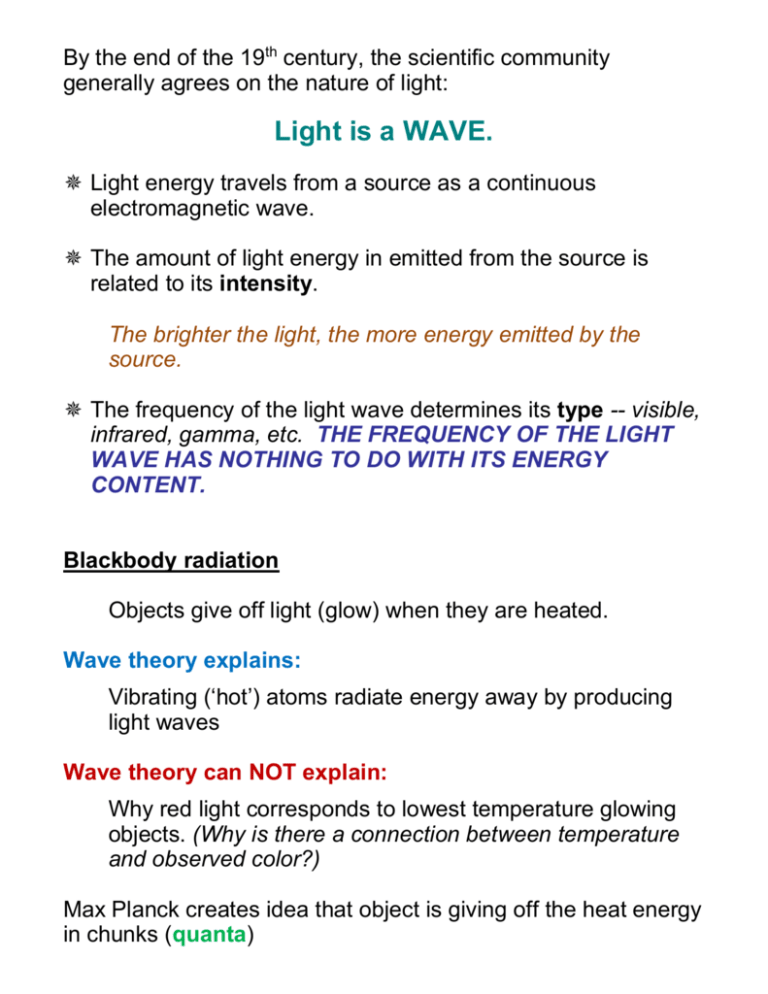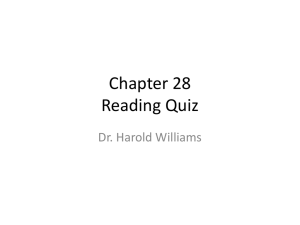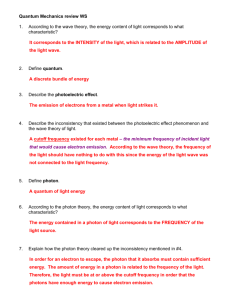Max Born – this `matter` wave represents a probability function that
advertisement

By the end of the 19th century, the scientific community generally agrees on the nature of light: Light is a WAVE. Light energy travels from a source as a continuous electromagnetic wave. The amount of light energy in emitted from the source is related to its intensity. The brighter the light, the more energy emitted by the source. The frequency of the light wave determines its type -- visible, infrared, gamma, etc. THE FREQUENCY OF THE LIGHT WAVE HAS NOTHING TO DO WITH ITS ENERGY CONTENT. Blackbody radiation Objects give off light (glow) when they are heated. Wave theory explains: Vibrating (‘hot’) atoms radiate energy away by producing light waves Wave theory can NOT explain: Why red light corresponds to lowest temperature glowing objects. (Why is there a connection between temperature and observed color?) Max Planck creates idea that object is giving off the heat energy in chunks (quanta) photoelectric effect The emission of electrons from a metal when light hits it. e- Wave theory of light explains: Electron absorbs energy of light wave, gaining enough KE to escape pull of nucleus of metal atom. Wave theory can NOT explain: Why electrons are only emitted if the incident light is at or above a certain minimum frequency – called the cutoff frequency. If the energy of light is related to its intensity, then only the brightness of the light source should matter; the emission of electrons should happen with any frequency of light used, as long as it was bright enough. Albert Einstein (1905) explained the cutoff frequency using Planck’s idea of a quantum (discrete bundle) of light energy Photon Theory of Light Light energy is emitted by the source as a stream of photons – light energy quanta The energy content of a photon is related to the source frequency E = hƒ (h = 6.63 x 10-34 J∙s) Planck’s Constant Ex: A photon of orange light (ƒ = 5.0 x 1014 Hz) has an energy content of: 3.3 x 10-19 J When a photon hits an electron it is completely absorbed. If the source frequency is high enough ( fc) the energy in the photon is sufficient to allow the electron to escape the nucleus. If ƒsource < ƒc the energy of the photon will not be sufficient to free the electron. Question: The cutoff frequency of a certain metal is 3.75 x 1014 Hz. How many 1.75 x 10-19 J photons will it take to dislodge a single electron from this metal? Another application of the photon theory of light – Compton Effect X-rays scattered by a crystal have a lower frequency than they did going into the crystal. The amount of change in ƒ depends upon the “scattering angle” ƒ < ƒO ƒ <<< ƒO X-ray source ƒO C R Y S T A L ƒ = ƒO ƒ << ƒO The larger the “scattering angle”, the lower the frequency Photons coming from source “collide” with crystal particles, transferring some energy to them. Larger scattering angle more energy lost by photon lower frequency http://www.student.nada.kth.se/~f93-jhu/phys_sim/compton/Compton.htm Louis DeBroglie: hypothesizes that if light has particle characteristics, perhaps particles have wave characteristics. He combined the photon equation (E = hƒ) with the energymass equivalence equation (E = mc²): mc² = hƒ (‘c’ denotes light speed, for particles...) mv² = hƒ mv² = h(v/λ) mv = h/λ h p Ex: A baseball of mass 145 grams moving at 40.0 m/s would have a “wavelength” of... 1.14 x 10-34 m (Macroscopic objects have wavelengths much too small to be observable) How about an electron moving at 300 m/s: what is its wavelength? DeBroglie’s hypothesis was tested with the ELECTRON DOUBLE-SLIT EXPERIMENT. Laser wave result Particle Beam Particle result Electron Beam Schrodinger’s idea Quantum Dice activity ? ? ? ? ? Max Born (German physicist) says this ‘matter’ wave represents a probability function that governs the motion of the particle. It identifies where the particle is most likely to be found. A particle moving with a specific momentum has an associated PSI WAVE (Ψ) of specific wavelength. | λ | A Δx λ momentum of particle ( from mv = h/λ) Δx possible location of particle A probability of particle being in that location (A² = probability density) * No certainty to location of particles, just probabilities – like rolling dice. Since waves have a tendency to spread out, Δx would be infinite in extent – the particle would have an equal probability of being ANYWHERE! To ‘localize’ the particle, decrease the Δx of its psi wave by adding other Ψ’s of different wavelengths. This produces a wave packet: Δx (much smaller) * PLUS: The amplitude of the wave is largest in the middle – the particle is most likely to be at the center of the Δx region. The trade-off: Now the particle’s psi wave is made of several different wavelengths, which means the particle has a range of possible momenta, not a specific momentum value (like it had originally). IN BECOMING MORE CERTAIN OF THE PARTICLE’S LOCATION, YOU BECAME LESS CERTAIN OF ITS MOMENTUM! http://www.fen.bilkent.edu.tr/~yalabik/applets/collapse.html Heisenberg Uncertainty Principle It is impossible to know the exact location and momentum of a particle simultaneously. The more certain you are of one quantity, the less certain the other one becomes. Δp ∙ Δx h / 2π * Momentum and location are mutually exclusive quantities. (This goes completely against the deterministic view of the universe.) CONSEQUENCES OF THIS THEORY: • The subatomic world is made of particles whose motions are governed by probability functions. (Light is made of particles; its wave properties are due to the probability waves associated with its motion.) THESE PARTICLES ARE ALWAYS IN MOTION. • • Individual particle events – where one particle ends up after traveling through an environment – are completely random. (The results of a collection of these events can be predicted statistically.) This uncertainty (randomness) is part of nature; it is not due to our lack of intelligence or technology. http://www.fen.bilkent.edu.tr/~yalabik/applets/collapse.html Quantum Tunneling Place a charged particle in a “cage” made by insulating material. Classical physics says the particle can’t escape. If “cage” dimensions are small enough, the particle’s psi wave could exist outside of the cage. Therefore, the particle would have a non-zero probability of existing outside of the box. - e At some point, the particle may disappear from inside the cage and reappear outside of it – effectively tunneling through the barrier! e- Anti-Matter Predicted to exist by Paul Dirac. (1930’s) Another form of Heisenberg Uncertainty Principle says ΔE ∙ Δt h / 2π This says that if the time interval is extremely small, the energy of a region will be very uncertain. Therefore, a region of empty space (which would have zero energy over a large time interval) could instantly contain a non-zero amount of energy. This energy would exist in the form of two particles. One would be an ordinary particle, the other with the same mass but opposite charge (the anti-particle). The anti-electron (positron) would have the same mass as an electron but would have a +1 charge. This process, in which an energy fluctuation creates a particle and its corresponding anti-particle, is known as pair production. If a particle and its corresponding anti-particle meet, they will annihilate each other, producing pure energy. This process is called pair annihilation. Quantum Entanglement If two particles are created together during some interaction, their psi waves could be “connected”. Changing the properties of one particle would cause a similar change in the other particle, even though they may be separated physically by a great distance! Beam Splitter (creates two entangled photons) When this photon reaches its far-away lab destination, its polarization is found to be shifted 45°, just like the other one! Rotates photon polarization 45° Photon detected in far-away lab







